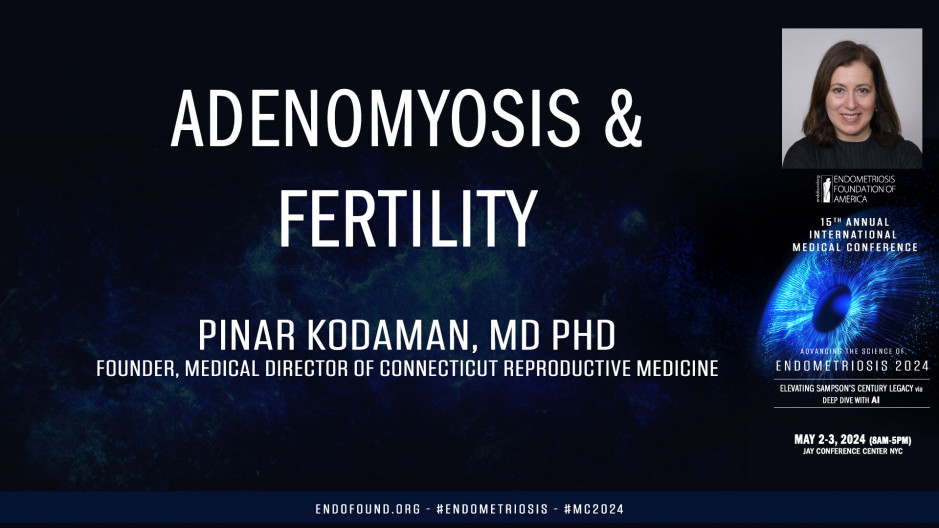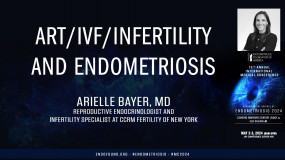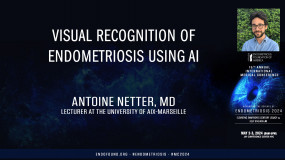International Medical Conference
Endometriosis 2024:
Elevating Sampson’s Century Legacy via
Deep Dive with AI
For the benefit of Endometriosis Foundation of America (EndoFound)
May 2-3, 2024 - JAY CENTER (Paris Room) - NYC
Okay, great. So I'm honored to be here to talk about a topic that's near and dear to my heart. I know myosis in fertility and we heard some really good talks on adenomyosis in the previous session and learned about all the fascinating research that's underway to better understand this enigmatic condition that puzzles us on the clinical realm. So briefly, adenomyosis is similar to endometriosis in that there are endometrial glands and oma endometrium like endometriosis. It is estrogen dependent and progesterone resistance. And as you can see here, there's different types from focal lesions that can be singular or multifocal versus this diffuse adenomyosis that involves an entire wall or the whole uterus versus adenomas, which are focal in a sense, but they're like omas with less distinct margins. The pathogenesis remains somewhat poorly understood, but the leading theory is that there's an imagination of the endometrial beal layer into the myometrium, whether just with time or with microtrauma or injury.
Other theories include metaplasia of Malian remnants or differentiation of adult stem cells. And it's certainly possible that these are contributors as the disease, just like endometriosis can also be heterogeneous in terms of its presentation. What we do know is that there's alterations in sex steroid receptor expression and sensitivity proliferation and fibrosis, which you see here, asymmetrically in the anterior wall inflammation and neuro angiogenesis, which can result in many of the symptoms. So the symptoms of course, are enlarged uterus, abnormal uterine bleeding, dysmenorrhea, dyspareunia, as well as pelvic pain. And then for the purposes of this talk today, subfertility infertility as well as pregnancy complications, which are beginning to be better understood. So while historically adenomyosis was diagnosed mostly on multiparous women at the time of hysterectomy, the more recent advances in imaging techniques, particularly with MRI and good quality ultrasound, have allowed us to make this diagnosis with 90%, approximately 90% sensitivity in younger women. And so on MRI, we're looking for a thickened junctional zone, which you can see here transvaginal ultrasound. We can see myometrial cysts, asymmetrical thickening, again seen here on this wall of the uterus, as well as an irregular endometrial myometrial interface. Of course, the histopathologic diagnosis is confirmatory, but this is pretty much pathognomonic as well for this condition. Prevalence, again, this is sort of a moving target because we're advancing our ability to diagnosis condition noninvasively. So it's more commonly found in women of reproductive age now, not just at the time of hysterectomy. Did something happen?
Sorry. And then we also know that it can be associated with other conditions like endometriosis. Did I do something with this? Sorry. As well as with bio myomas. Interestingly, it's found not infrequently among infertile women with a prevalence of 24.4% in women that are infertile over the age of 40 and a little less in those that are younger than 40. And among women who have endometriosis and infertility, there are reports of it being present in 70% of that population. Okay, be careful not to touch anything. So treatment options, of course, these are all options that will preclude pregnancy, but we will touch upon some of them as potential adjuvant therapy among women who want to conceive. But as you know, there's various medical options including combined hormonal contraceptives, progestin only medications, GnRH agonists, as well as now oral antagonists that are available for use as well as surgical treatment in the form of adeno myomectomy.
Adenomyosis is debulking as well as of course, the definitive treatment with hysterectomy. And there's decent evolving data on the potential benefit of uterine artery embolization in terms of symptom control, but also some initial preliminary data on potential benefit from a fertility perspective. So adenomyosis impairs fertility in a different way relative to endometriosis. So while infertility and endometriosis tends to be associated with distortion of pelvic anatomic structures due to adhesions and pelvic inflammation, there's different mechanisms that are at play, which we heard about a little bit in the previous talks in the previous session, including hyper peristalsis, increased uterine fibrosis and inflammation. All of these can then result in abnormal uterine contraction, which can affect tubal transfer support, sperm ova interactions, as well as abnormal endometrial function in the form of endometrial receptivity and impairment of the window of implantation, which can then lead to abnormal placentation and the pregnancy complications associated with that.
So altered implantation is typically what's seen, including delayed implantation endothelial inflammation, which is associated with increased oxidative stress and shallow trophoblasts invasion. Remember that implantation is a process where the egg, sorry, the early embryo and blasts form enters the endometrial cavity around day five six, at which point it hatches from the zone of lucita. And then there's the processes of opposition adhesion, invasion for pregnancy to ultimately ensue. So when we have a complicated processes like this, we may end up with either infertility or if there's delayed implantation, sometimes abnormal implantation in the form of placenta preview, low lying placenta, you might imagine if there's poor trophoblasts invasion or implantation that's limited. You can have recurrent pregnancy loss or recurrent implantation failure, which is a big challenge that we see in the world of assisted reproductive technologies. And then of course, there are other pregnancy complications that we all know can ensue when there's abnormal placentation, including things like preeclampsia, small for gestational or age or IEGR.
So let's shift gears and talk a little bit about adenomyosis and a RT generally speaking. Well, first of all, let me just say that the studies are limited because these are mostly retrospective studies and systematic analyses, and there's obviously some heterogeneity there. Of course, there's that huge overlap that between adenomyosis and other conditions like endometriosis and fibroids, which can also be confounding variables. But the general consensus is that clinical pregnancy rates, as you can see here, are decreased as our ongoing pregnancy rates, live birth rates, as well as miscarriage rates in most of the analyses of adenomyosis and IVF.
And so generally we see a 28% reduction in clinical pregnancy rates, decrease in live birth rate, as well as decreased clinical pregnancy rate for embryo transfer. And then, as I mentioned, increased miscarriage rates. Now, whenever we have a question in the world of a RT about whether it's the chicken or the egg, in other words, is it the embryo or is it the endometrium? We do donor cyte studies, right? So in this study that was done a while ago, now, donor cytes were taken from healthy young women without adenomyosis or endometriosis and then transferred into women with or patients with either adenomyosis endometriosis or control. And what you can see actually is that when we use really good quality eggs from younger women, that there are no significant changes in implantation rate or clinical pregnancy rate. But what holds true is that the clinical miscarriage rate remains elevated, particularly in the adenomyosis group relative to endometriosis and the control.
And there's a decrease also in the term pregnancy rate and the adenomyosis group compared to the endometriosis versus the control groups receiving these donor cytes suggesting that of course there is some inherent issue with the uterus among the patients with adenomyosis. So those issues then have been shown to result in several obstetric complications, which is just beginning to be appreciated in the clinical realm in terms of counseling and in terms of preparation in terms of the treatment of these individuals. So preterm deliveries, increased preterm, premature rupture of membranes, uterine rupture, postpartum hemorrhage, small for gestational infants, as well as preeclampsia fetal mal presentation, which of course in of itself is a risk factor for cesarean section. So interestingly and positively speaking, there is no difference in the rape. I did it again, sorry, intruder and fetal demise as well as I don't know what I'm doing there, but no difference in the rate of intrauterine fetal demise or APGAR scores.
I think when I hold this to too long, something happens. I'm just not going to hold, sorry, I'm not going to use that. Okay. Okay. So no difference in IUFD and AP course scores less than seven, so at least that's promising. Now, clinically, we have limited options in terms of how to treat these patients who desire to conceive with a RT. And there are some treatments that we may consider for which there's not perfect data, but some promising data at least thus far. And one of the potential medical management options is to use GnRH agonist, which is antiproliferative, it induces apoptosis as well as decreases inflammation in angiogenesis and collectively reduces uterine size. So when we look at several studies of the use of JRH pretreatment, although this was standard of care, it's sort of been re-looked at multiple times, what we do see is that there is an increased chance of spontaneous pregnancy.
Typically, the pregnancy rate, spontaneous pregnancy rate is around 15 to 18% in this study. But down by Roel where there was six months of post-op treatment with GRH agonists, there was a 40% pregnancy rate versus 15. And then similarly, if we use a long protocol for IVF simulation, meaning we suppress the ovaries with GnRH agonists in the luteal phase, mid luteal phase of the previous cycle, rather than use antagonist, which is the more common protocol, we do see a higher pregnancy rate and live birth rate when we do fresh embryo transfers. Okay? And this study was specifically looking at women with endometriosis and adenomyosis. So it's a little hard to tease out again because of the coexistence of these conditions. But what's important to note is that while there may be a benefit of GnRH agonist pretreatment for these IVS stimulations when a fresh embryo transfer is planned, there's no difference when we do frozen embryo transfers, which is primarily what most patients undergo these days, and that's probably due to the fact that it's a different type of treatment of the uterus where we're using high dose progesterone and intramuscular form to prepare the uterus and may overcome some of that progesterone resistance in whose study more recent study.
There is also evidence that an ultra long protocol, meaning three months suppression of the uterus in adenomyosis patients prior to starting IVF stimulation may be better in terms of clinical pregnancy rate, implantation rate, and live birth rate relative to the long protocol, which again involves using GN RH agonist in the mid luteal phase prior to stimulation. So an interesting study that came out in 2019 small, but I'm always interested in mechanism and why these things can be helpful. GnRH agonist therapy seems to increase elasticity. So in this small prospective observational study done by Z, they looked at six months of agonist treatment among infertile patients with adenomyosis diagnosed by imaging and compare the elasticity score before and after, and then followed them for six months. So the elasticity score is this newer technique used in the world of sonography where the different colors that you see on the right sided panel indicate how stretchy the myometrium is with red being more elastic and blue being more stiff.
And what was found in this group of patients is that the patients that conceived were more likely to have improvements in their elasticity score versus those that did not, even though all the patients showed improvement in adenomyosis symptoms CA one 20, CA 1 25 levels decrease in all and acid uterine size, but it was those patients specifically that had improved elasticity of their uterus that were able to conceive spontaneously. So suggesting that perhaps there's a subset that response to this medication in a certain way that may be beneficial from a fertility perspective. Adenomyosis debulking is a pretty involved and morbid surgery, but has some benefits. There's laparoscopy for focal disease, laparotomy for diffuse disease. Oftentimes because of the disruption of the shape and size of the uterus, a RT will often be required to conceive post-op. And of course there's a risk of uterine rupture and recurrence because adenomyosis is a diffuse infiltrative condition.
So this is just one of my Aden, my ectomies, that I wanted to just show you briefly where there's a young woman in her twenties having refractory pain despite medical management, and we went in and removed the adenoma, reconstructed the anterior wall, and of course found some coexisting endometriosis and resected that as well. So if we look at a large meta analysis of about 1500 patients looking at surgery alone versus surgery and medical treatments for the treatment of diffuse versus focal adenomyosis, you do see that there is some improvement in pregnancy rate, successful delivery rate, and obviously there's no controls here. It's just looking at adenomyosis patients. But again, knowing that the baseline underlying spontaneous pregnancy rate is around 50 18%, we see some improvements particularly in the focal adenomyosis group where there might be in fact a synergistic effect between medical and surgical management.
Again, prospective studies are needed to confirm these findings, but these are certainly suggested of some potential benefit in the subpopulation. And please note that in the diffuse group, there was an almost 7% increase in uterine rupture from surgery, which is pretty high and does require adequate counseling and surgical ability and training to make sure that that uterus is repaired in multiple layers as effectively as possible. So in terms of a prospective study, this is a small study out of Japan, which sort of questions whether medical or surgical treatment is actually of any benefit. And these are specifically patients with just adenomyosis, not endometriosis. And in this study, there's no clear benefit of either medication treatment prior or conservative surgery relative to no pre-treatment, both in terms of spontaneously conceived pregnancies or a RT. So more studies are needed. I think we can conclude from what's available out there that there is an increased chance of spontaneous pregnancy with adenomyosis treatment, and people have looked at uterine artery embolization use of IDs embedded with medication to suppress the adenomyosis, as well as combined hormonal contraceptives with some suggestion of benefit.
In addition to the GN RH agonist treatment for a RT, it's not routinely recommended to suppress patients with GRH agonist. This is the current guidance from the European Society of Human Reproduction and embryology. Again, as I mentioned earlier, because we use high dose exogenous steroids and frozen embryo transfer cycles, it really does optimize endometrial receptivity without any need for medication pretreatment or surgery for the most part. But of course, for refractory cases or if there's coexistence symptoms, one can always consider surgery with or GnRH agonist pretreatment or both. There's no clear date on the use of GnRH antagonist. There's the pregnant trial ongoing multicenter trial based at my former institution at Yale where aware women with endometriosis are treated with PO antagonists prior to an IVF cycle. Again, this is endometriosis patients, not adenomyosis patients, so we'll have to see if those results are generalizable.
Please remember that in those patients for whom we can't achieve successful implantation, there is also the option of gestational surrogacy, which is expensive, but obviously it works very well. So in terms of future directions, as I wrap up here, more studies are needed. Early detection and intervention are key. There are novel treatment approaches, as I alluded to, that are being developed and we need to focus on access to a RT for all in need regardless of where those patients live in the country and elsewhere. So adenomyosis coexist with endometriosis. We need to focus on early diagnosis of this condition. In addition to its sister condition endometriosis, we know that treatment can improve fertility. A RT is frequently needed, as well as remember, because of the known obstetric complications, preconceptual concept counseling is critical as well as close obstetric monitoring. And one should consider referring severe cases of adenomyosis, particularly those who've had debulking where rupture risk is quite high to a tertiary care OB center. I'll end there and I think we'll leave questions for later. Thank you.










